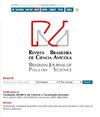Daily Egg-Cycle in Japanese Quail: Serum Biochemistry, Bones, and Oviduct Changes
IF 1.1
4区 农林科学
Q3 AGRICULTURE, DAIRY & ANIMAL SCIENCE
引用次数: 0
Abstract
This study described changes in the serum biochemistry, morphology of genital organs, long bone, and eggshell during the daily egg formation cycle in Japanese quails. Sixty quails (18-wk) were distributed in 6 groups according to hours post-oviposition (POV): 0 hr POV (16h00), 2 hrs POV (egg in magnum), and 4, 8, 14, and 20 hrs POV (egg in uterus). The magnum had higher relative weight before the next ovulation (20 and 0 hr POV), and its tubular glands showed functional variation through periods: abundant eosinophilic, PAS+, and negative Alcian blue secretion at 0 and 2 hrs, empty glands aspect at 4 hrs, and filled again at 20 hrs POV. Serum albumin and total Ca had the highest value in the 2 hrs group, and the lowest in 8 and 14 hrs groups. Egg-cycle period affected the Ca% of the medullar bone of the femur and tibiotarsus, with the lowest mean at 14 hrs POV (06h00), and the highest mean after oviposition (0 hr POV), showing the recovery of Ca stores in long bones for the next egg cycle. Analysis of the eggshell using scanning electron microscopy evidenced that palisade layer formation starts during the night (8–14 hrs POV), and most parts are secreted during the day period. In conclusion, eggshell secretion in light periods, high magnum activity and medullary bone Ca deposition during midday and afternoon, as well as the ovulation/oviposition in the afternoon, are the main characteristics of the distinct physiological aspects of the egg cycle in quails.日本鹌鹑每日产蛋周期:血清生化、骨骼和输卵管变化
本文章由计算机程序翻译,如有差异,请以英文原文为准。
求助全文
约1分钟内获得全文
求助全文
来源期刊

Brazilian Journal of Poultry Science
农林科学-奶制品与动物科学
CiteScore
1.80
自引率
9.10%
发文量
60
审稿时长
>12 weeks
期刊介绍:
A Revista Brasileira de Ciência Avícola surgiu em 1999 a partir da necessidade que a comunidade científica possuía de um periódico para veiculação e publicação de seus trabalhos, com a publicação de três números anuais.
A Revista conta hoje com um corpo editorial altamente qualificado e com artigos científicos desenvolvidos pelos maiores especialistas da área, o que a cada dia atrai mais leitores em busca de inovação e respaldo técnico.
Devido à credibilidade que conquistou pelos esforços de sus autores, relatores e revisores, a Revista ganhou caráter de coleção, sendo consultada como fonte segura de estudo desenvolvidos na Avicultura.
A partir de 2003 – volume 5 -, a Revista passou a chamar-se Brazilian Journal of Poultry Science, e todos os trabalhos passaram a ser publicados em inglês. No mesmo ano subiu para quatro o número de revistas por volume, ampliando-se assim os trabalhos publicados anualmente.
 求助内容:
求助内容: 应助结果提醒方式:
应助结果提醒方式:


